When designing Tasha’s Cauldron of Everything, the game designers at Wizards of the Coast tapped veteran RPG puzzle designer Elisa Teague to create nearly an entire chapter's worth of puzzles for your D&D game. Her work includes the masterful Alternate Reality Game that preceded D&D Live 2018: Stream of Many Eyes, known commonly as the “Leave No Stone Unturned” puzzle. Let’s expand on her masterful work and create simple, useful rules for designing puzzles for your dungeons!
What is a Puzzle?
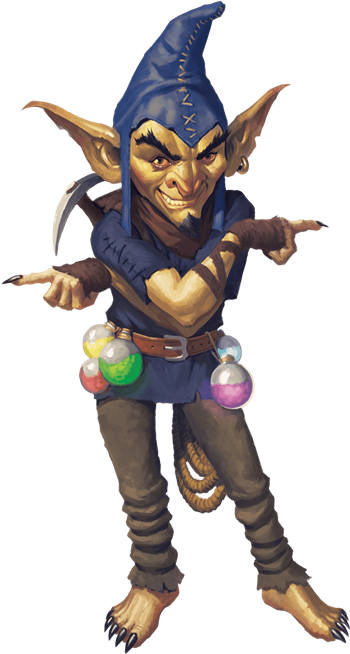 Of course, we all know instinctually what a puzzle is. It’s a test of cognitive skill to solve a challenging, often abstract task. There are dozens of different types of puzzles, and designing your puzzle around a classic archetype can make it easier to create a puzzle than starting from scratch every time. The trouble is, with so many different types of puzzles, how can you know what types are fun to untangle in D&D, and which will leave you bored?
Of course, we all know instinctually what a puzzle is. It’s a test of cognitive skill to solve a challenging, often abstract task. There are dozens of different types of puzzles, and designing your puzzle around a classic archetype can make it easier to create a puzzle than starting from scratch every time. The trouble is, with so many different types of puzzles, how can you know what types are fun to untangle in D&D, and which will leave you bored?
There’s no one-size-fits-all solution; every D&D group is made up of players with different tastes and preferences, so something that wins your Friday group over may fall flat with your Sunday group, and vice versa. And that’s to say nothing about your own preferences as a Dungeon Master! Don’t forget that you should be having fun in-game, too.
- Word Puzzles. Like the Reckless Steps puzzle in Tasha’s Cauldron of Everything, word puzzles rely on the players to identify words or letters, like an in-universe crossword puzzle.
- An oral cousin to the more visual word puzzle, a good riddle (like the Eye of the Beholder puzzle) gets you to think about hidden meanings in phrases.
- Number Puzzles. Some classic puzzles require you to arrange numbers in a specific order, like a Sudoku puzzle. Exact Change is a good example of this type of puzzle. Additionally, a number of puzzles in Tasha’s Cauldron of Everything also use numbers and words together, requiring you to think about the relationship between letters and numbers. Members Only is a good example of this type of combination puzzle.
- Logic Puzzles. These puzzles, like the medium puzzle Four-By-Four test inductive reasoning and relationships between puzzle elements. They are often solved using a logic matrix.
In-Character Knowledge versus Out-of-Character Reasoning
When solving a puzzle, should players use what they know from the real world, or can they only use the knowledge that their characters have? Likewise, should they use their own intelligence, or should they try to play to their character’s level of intelligence? How do you pretend to not know things if you’re playing an uneducated mercenary with only 8 Intelligence—or worse, how do you magically become smarter than you are if you’re playing a sage with 19 Intelligence, a genius-level intellect?
This vexing problem becomes worse if the Dungeon Master and the players are in disagreement about what the right way to handle a puzzle is. Disaster ensues if the DM wants the players to solve the puzzle in-character while the players want to use any means at their disposal to emerge victorious.
There’s no right answer to this problem—every table is different, after all—but the most one-size-fits-all solution is to just let the players use real-world knowledge and their own intellect to solve the puzzle. Don’t ask them to dumb themselves down to the level of their characters. And if a player isn’t as smart as their genius-level wizard, have some hints on hand that use the characters’ ability scores and skill or tool proficiencies to find information that they might not have otherwise thought of out-of-character.
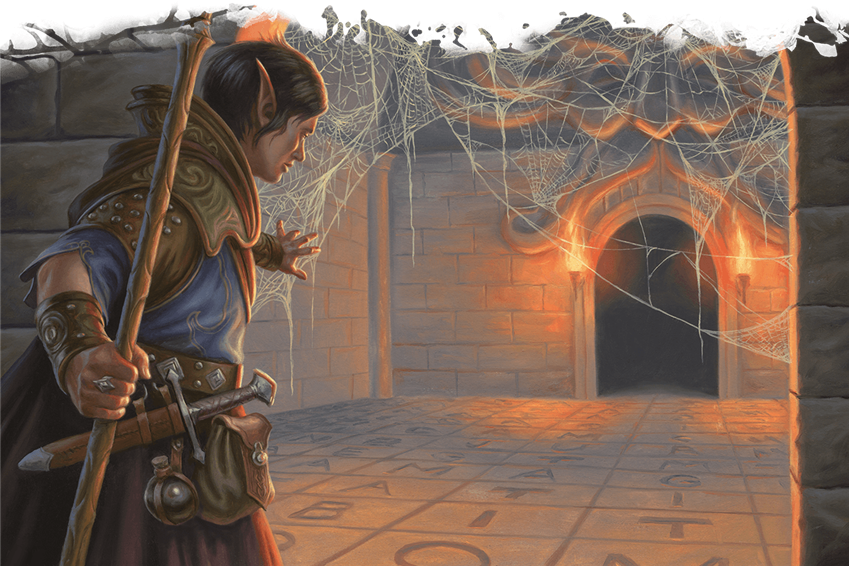
A Puzzle’s Story
Being a Dungeon Master means learning a little bit of game design to make sure that your game is specially tailored for your players. Soup from a can tastes fine, but imagine the difference between canned chicken soup and a hearty, homemade soup made from bones you’ve stewed for hours. If you want to make gourmet puzzles for your D&D group, you have to understand that the mark of a good puzzle isn’t necessarily that it confounds the players—it’s that it creates a satisfying story. D&D is a group activity played with friends, and often keeping the game moving is more important than providing a devilish challenge. The secret to making a good puzzle is landing the bullseye in the dead center of flow and difficulty.
That bullseye is a puzzle with a story arc with rising action and challenges, just like you might see in a Storytelling 101 class. If the puzzle was well-designed and well-suited to the players’ skill, they will feel like they’ve gone on a narrative journey when they solve it, rather than simply overcoming a speed bump. Here’s a three-step process to making a narratively satisfying puzzle.
The Question and the Statement
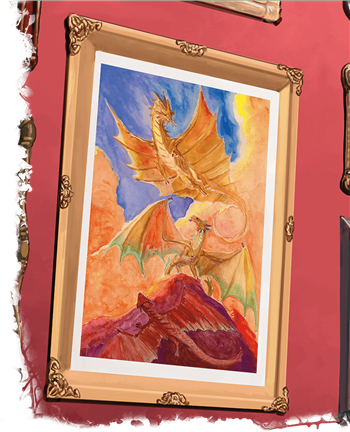 The puzzle begins by making a statement and posing a question. This could be a literal statement of terms, such as a bronze plaque which states: “To progress past this room, you must speak aloud the names of the Five Great Kings of Oa.” The room is filled with a dozen portraits of people, each with their name inscribed on the frame. In this situation the question is implicit; the room asks “which of these dozen people are the Five Great Kings of Oa?” The characters must figure out that these portraits have traits that a legendary monarch would have, such as a crown, a scepter, a signet ring bearing a royal crest, and so forth.
The puzzle begins by making a statement and posing a question. This could be a literal statement of terms, such as a bronze plaque which states: “To progress past this room, you must speak aloud the names of the Five Great Kings of Oa.” The room is filled with a dozen portraits of people, each with their name inscribed on the frame. In this situation the question is implicit; the room asks “which of these dozen people are the Five Great Kings of Oa?” The characters must figure out that these portraits have traits that a legendary monarch would have, such as a crown, a scepter, a signet ring bearing a royal crest, and so forth.
The statement doesn’t have to be so explicit, however. Consider how the puzzle changes if the characters entered this same room and you described the portraits, and then a locked door with the ancient royal crest of Oa upon it inscribed upon it five times in a pentagon. In this trickier scenario, the puzzle also requires the characters to:
- Realize that there’s a puzzle at all
- Infer the terms of the puzzle by their surroundings
Generally, it’s easier to give a puzzle an explicit statement and an implicit question. However, if you make your question explicit (perhaps a plaque upon the door which reads, “Only those who possess knowledge of history long-lost is worthy to pass me”), then you can still get the characters to infer the terms of the puzzle through their surroundings without requiring them to first realize that they’ve stepped into a puzzle.
The Wall and the Perspective Shift
All a puzzle really needs to be great is a statement and a question. That’s essentially just a riddle you’ve introduced some multimedia elements into. However, to make a puzzle truly exceptional requires you to borrow from the magician’s playbook. Anyone who’s seen The Prestige (the 2006 film by Christopher Nolan) knows that there are three stages to a real-life magic trick: the pledge, the turn, and the prestige. In many ways, this applies to a good puzzle, because the goal of the illusionist and the puzzle master are the same: tell a compelling story. The main difference is that the illusionist wants to conceal the inner workings of their magic, whereas the puzzle master wants the audience to understand the puzzle inside and out to discover the solution.
In this magician’s schema, “the turn” is when something that’s ordinary is revealed to be extraordinary. The audience’s expectations are turned on their head—it shifts their perspective. In a puzzle, the perspective shift occurs when the puzzlers hit a wall. Their premises were flawed; something they thought was certain about the puzzle—typically the statement—is wrong. It’s not an outright lie, that would be a dirty trick, but the statement was phrased in such a way to play upon your assumptions. This wall will stand impenetrably tall unless the puzzlers stop for a moment, step back, reconsider what they took for granted to be true, perhaps incorporate new information they learned elsewhere, and see the puzzle with fresh eyes.
Since this section of the puzzle is often where players get stuck, it’s important to have a few hints prepared (as discussed in the “Puzzle Elements” section of Tasha’s Cauldron of Everything). Having hints that the characters can make checks to discover helps strike a balance between not just player knowledge vs. character knowledge, but also between challenge and game flow.
One good way to do this is to tie the puzzle into the larger scheme of the campaign, or the even just the dungeon the puzzle is found in. In our portrait example, let’s say that the dungeon so far has been themed around dragons—the five colors of chromatic dragons, specifically. Statues litter the dungeon depicting ancient kings (with long-eroded faces), and each one of these kings has a differently colored chromatic dragon at his side. No such dragons appear in the portraits, but astute characters will realize that even though many of the people in portraits appear to be noble, even regal, only one portrait each shows someone dressed in black, blue, green, red, and white. These kings are not all dressed in regal finery, but instead wear the color of their bonded dragon.
The Epiphany
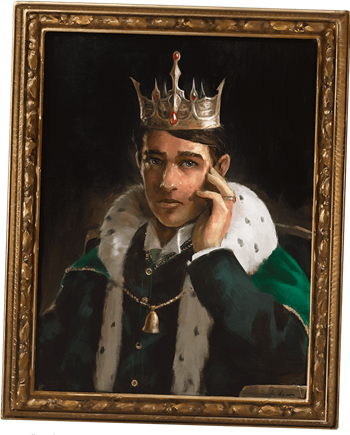 The perspective shift is the key to unlocking the entire puzzle. Once the characters have changed their perspective, the rest of the puzzle should rapidly fall into place, causing the wall that blocked them to crumble away until the solution is clear. This is a series of rapid-fire epiphanies as the puzzlers apply their newfound perspective to individual puzzle elements in turn. The key to this epiphany is rooted in the beginning of your puzzle; it has to be rooted in clear, simple concepts, not cheap tricks. Indie puzzle game designer Jonathan Blow (Braid, The Witness) told Gamasutra in 2014, "...the more that a puzzle is about something real and something specific, and the less it's about some arbitrary challenge, the more meaningful that epiphany is."
The perspective shift is the key to unlocking the entire puzzle. Once the characters have changed their perspective, the rest of the puzzle should rapidly fall into place, causing the wall that blocked them to crumble away until the solution is clear. This is a series of rapid-fire epiphanies as the puzzlers apply their newfound perspective to individual puzzle elements in turn. The key to this epiphany is rooted in the beginning of your puzzle; it has to be rooted in clear, simple concepts, not cheap tricks. Indie puzzle game designer Jonathan Blow (Braid, The Witness) told Gamasutra in 2014, "...the more that a puzzle is about something real and something specific, and the less it's about some arbitrary challenge, the more meaningful that epiphany is."
In our example, once a character realizes that each of the Five Great Oan Kings was bonded to a chromatic dragon, the realizations that each of the kings bears the color of their dragons should come fast and furious. “This one’s the only one wearing red! This one’s the only one in white…” until the puzzlers find the solution and open the door.
It’s possible that, if the players are particularly canny, their perspective will be properly aligned right from the start. So there will never be an epiphany, just a rather limp discovery that their first guess was right all along. It’s always disappointing when this happens, but don’t despair. Take that as an indication that you can ratchet up the difficulty of your next puzzle to really get your players thinking.
Have you ever included puzzles in your D&D campaigns? What was one that your players will never forget? Let us know in the comments!
Create A Brand-New Adventurer Acquire New Powers and Adventures Browse All Your D&D Content
 James Haeck is the lead writer for D&D Beyond, the co-author of Waterdeep: Dragon Heist, Baldur's Gate: Descent into Avernus, and the Critical Role Explorer's Guide to Wildemount, a member of the Guild Adepts, and a freelance writer for Wizards of the Coast, the D&D Adventurers League, and other RPG companies. He lives in Seattle, Washington with his fiancée Hannah and their animal companions Mei and Marzipan. You can find him wasting time on Twitter at @jamesjhaeck.
James Haeck is the lead writer for D&D Beyond, the co-author of Waterdeep: Dragon Heist, Baldur's Gate: Descent into Avernus, and the Critical Role Explorer's Guide to Wildemount, a member of the Guild Adepts, and a freelance writer for Wizards of the Coast, the D&D Adventurers League, and other RPG companies. He lives in Seattle, Washington with his fiancée Hannah and their animal companions Mei and Marzipan. You can find him wasting time on Twitter at @jamesjhaeck.








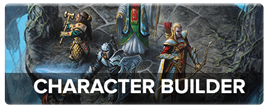
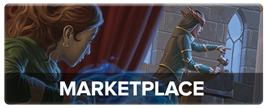
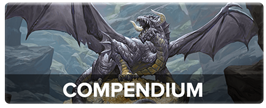
-
View User Profile
-
Send Message
Posted Dec 3, 2020One of my favorite puzzles that Ive used is a mirror that has its reflection change depending on the alignment of the character standing in front of it.
-
View User Profile
-
Send Message
Posted Dec 3, 2020IKR? lol people are all judgy about what makes a good or a bad DM. The point is to have fun so no matter how you make it fun, as long as players are happy it means the DM is doing a good job.
-
View User Profile
-
Send Message
Posted Dec 4, 2020Recently I started purchasing small real world puzzles for the group to solve together. Once they get the puzzle solved the door is unlocked or the chest opens or whatever. I leave a breadcrumb trail of hints before presenting the puzzle. The last one was a box I bought online for like $10, told them it is a box of holding if they can open it. Inside were some cheap trinkets that each had some in-game value, gives them another item to fiddle with during the game but they loved it. Instead of fighting over the objects they set the box of holding where they can all grab an item they need to use and then return it when done. The key to the box was a code spelling out the name of the town the box's creator came from, took them about ten minutes to solve and allowed me a quick break LOL. My group is unusual, they share everything to get their sessions done, other groups I play with may not be as willing.
-
View User Profile
-
Send Message
Posted Dec 4, 2020BarbarianBro is delving into his very own puzzle quest.
-
View User Profile
-
Send Message
Posted Dec 8, 2020I have run two puzzles in the last year (admittedly neither went all that well). Here were the in-game reasons:
One was a Legend of Zelda Lost Woods-style labyrinth where if the players took the wrong path, they would eventually wind up at the same three-way fork over and over again. The solution was very simple if you know what to look for (you must carry a torch, and choose the path paired with a fire symbol on a nearby tree, there were dummy symbols as well). The hag at the center of the forest designed the puzzle such that her henchmen could retreat quickly home, but anyone in pursuit would be at worst delayed, at best hopelessly lost and easy to pick off in the frigid woods. This is a concept that can be paired with basically any *kind* of puzzle. It's basically a magical version of a drawbridge at a castle--easily lets in the people you want to let in, greatly delays or keeps out the people you don't.
The other puzzle I ran recently was a word puzzle hidden in the titles of books/authors on a bookshelf. My players *always* look at books, far beyond my ability to improvise content, so I knew they'd look at it. The reward for the puzzle (which was too little, given the amount of time it took up--again, this puzzle wasn't great) was two pieces of information: (1) there's an illusory wall in the basement that leads to more of the dungeon and (2) the dragon in the dungeon does not realize that she is under a long-term charm by the boss of the dungeon. The puzzle is the (in her own right reasonably powerful) dragon's subconscious manifesting a cry for help to the players to, among other things, avoid killing her so she can be an ally, rather than fighting her as a mini-boss.
My execution on both puzzles wasn't as great as I'd hoped, but I share your concern with making sure that puzzles have a real explanation rather than "traps are fun."
-
View User Profile
-
Send Message
Posted Dec 9, 2020This is excellent -- I really like the mirror room idea, although if I'm reading it right, it's really more a point of frustration for adventurers rather than a puzzle? If there's no "other door" to reach, then there's no real "answer" to a "question", but rather just a dead end (or maybe a dead end with a flourish?) I imagine this would take some time for players to discover, something that a nasty dungeon constructor, lich, etc. could use to further punish would-be tomb raiders, maybe by creating increased threat elsewhere in the dungeon. Regardless, I hadn't heard about this one before, and am conceptualizing ways to incorporate this mirror room into my campaign!
I would love to hear more about puzzle elements in combat -- sounds like fun!
-
View User Profile
-
Send Message
Posted Dec 11, 2020Yeah, the mirror room is best used for bonus objectives, rather than something people have to go through. Bear in mind, that there are multiple ways to oops into solving it. (Running hands along the real wall, dropping an item (It's no longer held/worn, so it shows up in the mirror.) or just close observation of the mirror all give heavy hints as to what's really going on.)
EDIT: (Just realized that I misread your reply.) There is a real exit, it's just right next to the door the players enter from (And hidden by an illusion.)
As for puzzles in combat, basically anything that interferes with how the players normally act counts. The puzzle could even be solved by the party ahead of time, with hints given. Basically, you are looking to provide a moment of discovery. (Also enemy vulnerabilities are much more interesting than strengths.) Some examples are:
An ooze that gains resistance to a type of damage after being hit by it, at the cost of gaining vulnerability to the opposite type of damage.
A golem with an attack pattern that the players can learn and exploit.
A Faerie that is actually 10ft to the left of wherever they appear to be. (Warning: Can be irritating depending on how much AoE your party has.)
Terrain elements are also a really good way to add puzzle elements to combat. Some examples:
Portions of the floor are actually illusiory, and anyone who falls through takes 2d6 fall damage and has to waste a round climbing the stairs back up to the room. (Works really well with enemies that force movement)
There are several runes carved into the wall that provide the boss with their most powerful spells while active. Destroying the runes removes their access to those spells.
A mirror in the room provides a portal to the border ethereal. While there, certain objects that would otherwise be immovable can be moved and destroyed. (Such as the runes in the above example) However characters in the ethereal plane have resistance to all damage that originated from the Material plane, and vice versa.
-
View User Profile
-
Send Message
Posted Dec 13, 2020Thank you for some great ideas, I will probably use some of these. Here's an add-on to the illusory floor tiles:
You use the puzzle Reckless Steps that shows up in Tasha's, but the traps are falling or something(doesn't matter a whole lot what the traps are), but you also have monsters to fight as well as having to get across the room. The in-game reason for the puzzle is so that the monsters have an advantage in the fight. Also, you could make it some sort of guardroom, where the characters have to get past the monsters to continue, but whenever they fall, they have to climb back at the start.
-
View User Profile
-
Send Message
Posted Dec 15, 2020I just wrote a puzzle using "the Betrayal of the House on the hill" as a reference. It has several small mysteries that are designed to be completed as a group! Betrayal at Baldur's Gate is a very similar game. Check them out, they are very easily adapted as puzzles for your game.
-
View User Profile
-
Send Message
Posted Jan 1, 2021I have used a puzzle that I found online somewhere (apologies for not remembering the creator to give credit) in which players discovered a table with a bunch of circles carved into it, and lines connecting some of them together. To a careful observer, the circles were arranged in three concentric circles. The outer layer was meant to hold statues of animals. The middle layer held statues of beasts that can be thought of as combinations of animals, and the inner circle would be combinations of beasts from the other two rings. The lines showed the connections.
So, for example, the inner circle may have a sphinx (man, eagle, lion), the middle layer may have a griffon (eagle, lion), and the outer ring may have a man, an eagle, and a lion. Lines would connect them appropriately.
To help set it up, I decided to have the players discover/notice one or two statues in rooms before discovering the table. I had one or two statues in the correct spots on the table. And, since the dungeon was the castle of a trickstery arch-fey, the first room was a courtyard with an Alice-in-Wonderland tea party-inspired scene in which one of the participants was a “mad gnome” obsessed with combinations of beasts... just to plant the idea.
Players could ignore this entirely, or could decide to search out the remaining statues, solve the puzzle and gain a magical item that would make the final confrontation easier.
— I like puzzles that involve physical interaction with the dungeon, require extra effort/exploration, and offer bonuses instead of being required. I’m currently working on a dungeon that includes mechanisms to plane-shift the party between the shadowfell and the feywild. Navigating the dungeon is a Zelda-inspired puzzle wherein players must find a path that requires shifting between planes. It also provides the opportunity to plant hidden goodies that require noticing possibilities and occasional backtracking.
-
View User Profile
-
Send Message
Posted Jan 1, 2021This is a common fallacy. In fact, DMs who follow your advice are much worse, or else mistaken about how role-playing works.
Think about the differences in tactical decisions between Emeril, the 20-Intelligence wizard, and Bob, the player. Should a good DM let Bob rely on Emeril’s intelligence to make his round-by-round combat decisions? Because Emeril’s decisions would be far superior. Should the DM let Bob rely on Emeril’s intelligence to decide which path to take? - which NPC to trust? - which strategy to use to persuade the king? - which quest to complete first? - which path to take to the dungeon?
Once a DM adopts the method you recommend, he or she actually makes it impossible for a player to play at all. Literally every decision Bob makes for a Emeril must be overridden by the intelligence of Emeril, based on the method you recommend. And this isn’t even getting into the personality differences between player and character.
No, thank you. I prefer to let my players play the game.
I don’t think you could be more wrong.
-
View User Profile
-
Send Message
Posted Jan 2, 2021This. All this.
Arbitrary number puzzles, riddles, etc. are just dumb. The puzzle needs to exist for a reason and should be functional within the dungeon or room it's contained in. Don't put an arbitrary puzzle in the game because you think you need to... there needs to be a logic to it. Why would a puzzle exist in a bandit fortress, for example? There are bandits in there... they don't want to have to deal with the puzzle or its mechanics if the puzzle is in a mandatorily travelled hallway.
Honestly? Puzzles work better when you find random doors in the middle of nowhere, or a totally voluntary path in the dungeon.
Bad guys who do this "because they can" are pretty egomaniachal tropes and will probably pull me right out of any immersion i've given into your game.
-
View User Profile
-
Send Message
Posted Jan 2, 2021Wow, I didn’t think so much argument would spring up from such an article as this.
-
View User Profile
-
Send Message
Posted Jan 2, 2021Completely not letting the players rely on their own intelligence and logic is a bad idea, but so is never letting them use their abilities. It's really a careful balance between the two. If you are playing a character with an average intelligence(10 or 11) and you see the answer to the puzzle right away, is it fun to sit there and wait for your character to solve it? On the other hand, if you as a player are no good at IRL puzzles, but you have a character with a super high INT, it would make more sense for you to at least get a clue from your character's intelligence.
Basically, I would say the best range to be in is between focusing on character abilities but being able to fall back on your own logic and vice versa, although anywhere in between works too.
-
View User Profile
-
Send Message
Posted Jan 3, 2021I'm in the middle of a game, and my players has just ran into a puzzle I made for them, but they seem to be stuck! Should I give a hint or something?
-
View User Profile
-
Send Message
Posted Jan 3, 2021If they're stuck, sure, give a few hints, especially if you let their characters make an Int/wis(or another ability, but those are the most common) ability or skill check to find them - that will make it seem a lot less like you're just giving them a hint and much more like they figured it out.
-
View User Profile
-
Send Message
Posted Jan 4, 2021Well, I’m not usually very easily persuaded, but this response was so thoughtful and well-articulated that you’ve convinced me. Obviously, using the character’s intelligence score to restrict character options in favour of pre-determinism is better for role-playing. It must be, right? Predetermined success and failure is why we play, right?/endsarcasm
Nitpick: “crap advice” is incorrect. Since you’re using an adjective, “crappy advice” is correct. You’re welcome. For both corrections. When you get over your ego and realize I’m right, you’ll probably lack the courtesy to thank me, but you’re still welcome. Twice.
-
View User Profile
-
Send Message
Posted Jan 4, 2021I personally believe that you should use a mixture of a the intelligence of the character and the person playing it. For example, lets say you have a puzzle that requires you to match the holy symbol to the god. The player would have to realize what task is required (the matching) but the character would make an intelligence check to actually recognize which symbols go to which.
-
View User Profile
-
Send Message
Posted Jan 4, 2021Well said, thank you.
-
View User Profile
-
Send Message
Posted Jan 12, 2021This has really helped me create my first campaign and i managed to stump some of my friends!